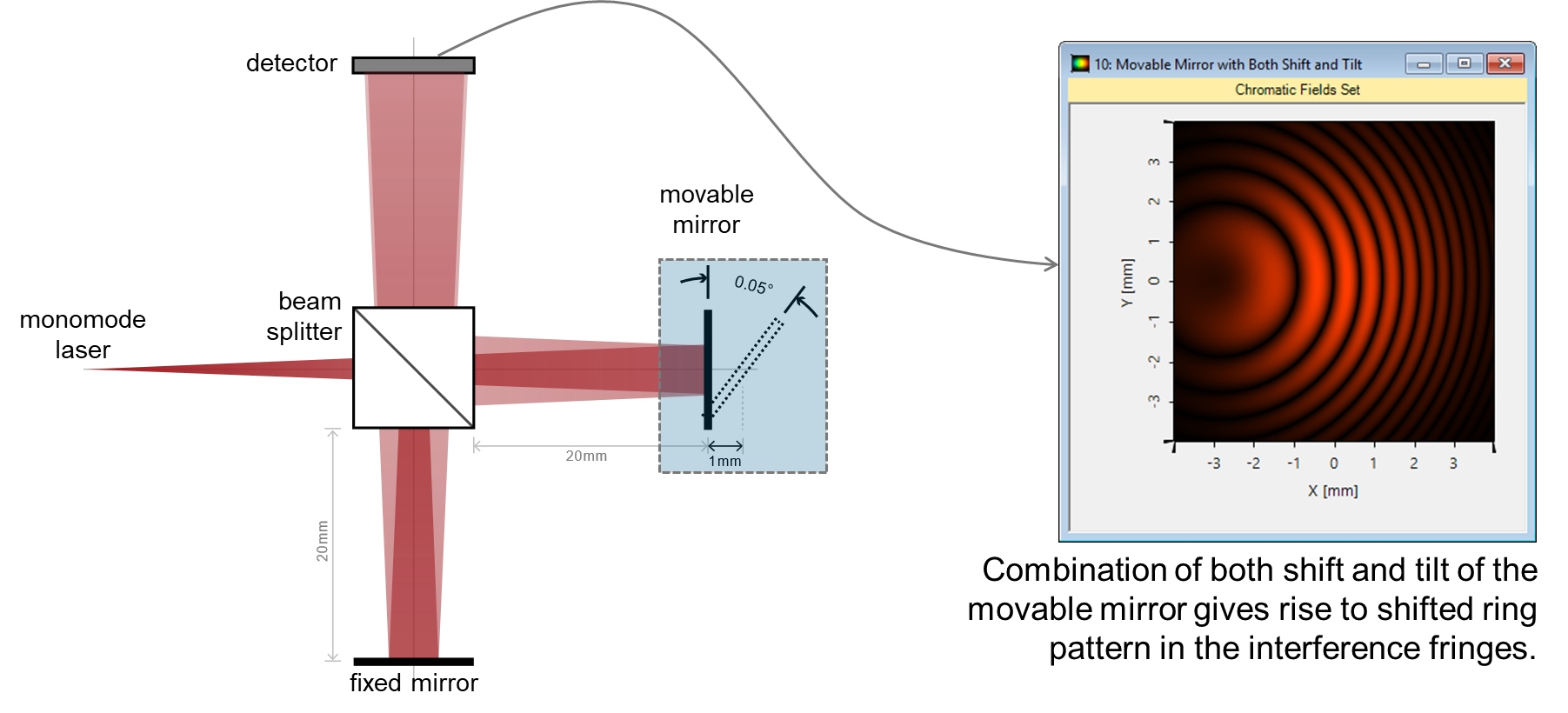‘Interferometry’ is a quantification method utilizing the phenomenon of interference of waves (customarily light, radio or sound waves). The quantifications may include those of certain characteristics of the waves themselves and the materials that the waves interact with. In addition, interferometry is utilized to describe the techniques that use light waves for the study of vicissitudes in displacement. This displacement quantifying interferometry is extensively utilized for calibration and mechanical stage kineticism control in precision machining.
Interferometry has wide application. interferometers come in a variety of shapes and sizes. They are habituated to quantify everything from the most minute variations on the surface of a microscopic organism, to the structure of cyclopean expanses of gas and dust in the distant Macrocosm, and now, to detect gravitational waves.It is additionally used to check the flatness of surface ,to check nature of surface, to check defects in material surface, and many more.This concept is additionally used to check whether a surface is convex or concave.
.png)
Abstract:
Interferometric metrology is now experiencing a major resurgence of interest due to several incipient developments. This blog presents an overview of current trends and a brief discussion of future prospects.
Working principle of infernometry is Splitting of a light beam into two beams that peregrinate different optical paths and then coalesce to engender interference. Infernometry works on the principle of superposition to coalesce waves that will cause the result of their coalescence to have some consequential property that is diagnostic of the pristine state of the waves.
History:
1)First Interferometer-Pioneer Fizeau Interferometer, year 1862 .

2) Second Interferometer: Pioneer Michelson Interferometer,year 1881.

3)Twyman-Green Interferometer,year 1916.

4)Laser Unequal path Interferometer(LUPI),year 1967.

5)Computer interferometer, 1970-1980.

What is new in interferometry?
As concerned in optics, no new additions. There are advancements in electronics, computers, softwares, etc… Things are possible to do which were just dreams in the past.
Current trends in interferometry: Click here
Inferno Meter is a contrivance which has application in a wide field of engineering, science, medical, space , technology etc. Interferometers are optical instruments utilized for quantifying flatness and determining the length of slip gauges by direct reference to the wavelength of light.Within the field of fiber optics, interferometers are employed in the precise quantification of minuscule displacements, refractive index changes, surface irregularities/topography, among other observational procedures. In the space industry, interferometry is utilized by astronomers to obtain the resolution of an immensely colossal telescope by coalescing the signals from multiple more minute telescopes that act as a single unit. An involute system of mirrors brings the light from the separate telescopes to the astronomical instruments where it is then processed in order to re-engender a high quality, finely detailed image.
Metrology is a branch of engineering which denotes science of quantification. Interferometry has its own application in metrology.interferometry measures surface roughness of the surface required.They are non contact contrivances , so no desideratum to scan the surface laterally.We can additionally get sub micron spatial resolution of surface.Results for all types of surfaces are positive (machined metals, glass, ceramics, plastics, paper etc…).
There are few types of interferometer which we are using currently –
1)Michelson Interferometer.
This is the oldest type of interferometer, which has subsequently been modified in several venerations and a plethora of sophistication introduced.Michelson utilizing this interferometer, established exact relationship between meter and red
wavelengths of cadmium lamp.The rudimental Michelson interferometer consists of a monochromatic light source, a beam splitter and two mirrors. It relies on the principle of constructive and destructive interference as one mirror remains fine-tuned and the other is moved.If both mirrors are at same distance from beam splitter, then light will arrive in phase and observers will visually perceive effulgent spots due to constructive interference. If a movable mirror shifts by quarter wavelength, then the beam will return to the observer 180° out of phase and tenebrosity will be visually examined due to destructive interference. Each half wavelength of mirror peregrinate engenders a vicissitude in the quantified optical path of one wavelength and the reflected beam from the moving mirror shifts through 360° phase Change.

Sun dry sophistications which have undergone to amend Michelson’s rudimental apparatus. They are :
(i) Utilization of laser as the light source ,
(ii) Mirrors are superseded by cube-corner reflectors (retro-reflectors),
(iii) In lieu of visually examining the interference phenomenon by ocular perceiver, photocells are employed which convert light-intensity variations in voltage pulses which are processed by electronic instruments to give the amount and direction of position change.

2) Twyman-Green Interferometer.
Twyman Green Interferometer is a specialisation of Michelson’s Interferometer.In the Michelson interferometer, the rays authentically describe a cone, giving ascend to sundry types of fringe patterns which may be hard to interpret. Twyman-Green modified Michelson interferometer utilises a pin-aperture source diaphragm and collimating lenses. In this way, all rays are rendered parallel to the central rays and thus all rays describe the same path. All modern two-beam interferometers are predicated on this arrangement.

Following care must be taken while operating this interferometer:
(i) It has been denoted that mirror should peregrinate precisely parallel to itself and no machines have ways adequately straight to maintain uniform fringe fields.
(ii) It is optically canvassed that the wavelength of light source is modified by the refractive index of air which is dependent on pressure, temperature and sultriness of air (wavelength is fine-tuned only in vacuum).
(iii) It has already been designated that the signal vigor becomes indigent if the path distinction between the rays corresponding to two mirror systems is high.
(iv) These high sensitivity interferometers are highly susceptible to vibration. The presence of vibration may either wash out the fringes consummately or may be very vexing for the observer. As already betokened, the utilization of Roster’s prism can truncate the quandary ofvibration to great extent.
(v) In order to be able to count the fringes corresponding to both forward and rearward forms of kineticism, two detectors, one focussing the dark fringe and other focussing the adjoining refulgent fringe, must be arranged.
3)N.P.L. Flatness Interferometer.
As the designation suggests, it is mainly utilized for checking the flatness of flat surfaces. The NPL flatness interferometer is utilized for checking flatness between gauge surfaces.This interferometer was designed by National Physical Laboratory and is commercially manufactured by Hilger and Watts Ltd. The flatness of any surface is judged by comparison with an optically flat surface which is generally the base plate of the instrument. This instrument essentially consists of a mercury vapour lamp.
This interferometer is utilized to check error in parallelism.

4)The Fitter—N.P.L. Gauge Interferometer.
This is additionally called the gauge length interferometer and utilized for determining authentic dimensions or absolute length of the gauges. As the mechanical sub-division of end standards length inclines to be laborious when minute lengths are considered, and due to liability of error in that method, direct quantification interferometer predicated on the design of N.P.L. is most commonly used.Since this involves very precision work, it is consequential to visually perceive that the physical conditions circumventing the quantifying equipment are standardised and controlled. The standard conditions being temperature of 20°C, barometric pressure of 760 mm of mercury with dihydrogen monoxide vapour at a pressure of 7 mm and containing 0.33% by volume of carbon dioxide. In case conditions are different, then redressment factors have to be applied.
This interferometer is utilized to do total phase rectification.

5)Laser Interferometers
The quantifying capacity in interferometers with lamp as source of light is circumscribed because it is not possible to maintain the sharpness of interference fringes beyond a certain distance due to the size of the lamp. Laser interferometer uses A.C. laser as the light source and thus enables the quantifications to be made over longer distance because it is possible to maintain the quality of interference fringes over long distances when lamp is superseded by a laser source.
It must be understood that white light emitted by a lamp is a cumulation of waves at different frequencies but a laser engenders a perpetual train of light waves, resulting into high coherence. Laser represents a source of profoundly monochromatic optical energy, which can be collimated into a directional beam. Withal laser beam wavelength is exact and pristine for highly precise quantifications. It utilises the principles of both optical techniques and digital electronics ; and is a highly precise and multifarious quantifying system that can cope with industrial environments.

AC laser interferometer (ACLI) position information is carried as phase deviation rather than as a signal amplitude deviation, thus giving a much amended signal to noise ratio over amplitude modulation, because the noise sources that affect signal amplitude have little effect on phase. In this way, ACLI is much more tolerant of environmental factors that attenuate the intensity of a laser beam, such as dust, smoke, air turbulence etc. It requires no warm-up time or standby power.ACLI has the following advantages: high repeatability and resolution of displacement quantification (0.1 um), high precision, long-range optical path (60 m), facile installation, and no transmutation in performance due to senescent or wear and tear.
A single laser source can be utilized for as many as six simultaneous quantifications in different axes. However, it is very much extravagant ; since the fundamental instrument measures physical displacement in terms of wavelength in lieu of traditional units, conversion instrumentation is required for conventional read out. Highest possible precision is obtainable only by compensating vicissitudes in air pressure and temperature which affect wavelength of the laser beam.
6)Dual-frequency Laser Interferometer.
This instrument is utilized to quantify displacement, high-precision quantification of lengths, angles, speeds and refractive indices as well as derived static and dynamic quantities. It operates on heterodyne principle. The frequency stability of He-Ne laser is responsible for outstanding performance of the interferometer. This system can be utilized for both incremental displacement and angle quantifications. Due to the astronomically immense counting range it is possible to procure a resolution of 2 nm in the 10 m quantifying range. Denotes are provided to compensate for the influence of ambient temperature, material temperature, atmospheric pressure and atmospheric sultriness fluctuations.
Note:Wavelength scanning interferometry is kenned as a method to quantify the surface topography of an object with high precision. However, it is arduous to obtain high-precision absolute quantifications with conventional techniques so Wavelength scanning interferometry proves vital.
Apart from these , many more interferometers are utilized but these are the commonly used interferometers.
Future Prospects:
Advancements in Interferometry had been quiet progresive. Advancements in computer, electronics, lens , optics, softwares, technology have given a boon to Interferometry. Advancements in these technologies in future will also lead to progresses in Interferometry.
There might be some advancements in light source technology , changes in lens and mirror compositions may prove vital in metrology of Interferometry. New setups to eliminate the drawbacks of currently used technologies may come. There is lot of scope in future of interferometric metrology.




